Diabetes is a lifestyle condition that causes high blood sugar and insulin resistance. But yes, it is possible to reverse it by keeping the body active with other lifestyle modifications such as eating right, sleeping enough and stress management help in controlling diabetes. One of the most effective ways to control diabetes is to start keeping your body active by working out. Actively exercising helps in controlling blood sugar levels, improving insulin sensitivity, reducing HbA1c levels and improving body composition in Diabetic patients. It also reduces anxiety, mental tensions, mood swings and promotes overall well-being.
What happens when a diabetic remains lazy?
If a diabetes patient doesn’t involve in physical activities, their body tends to lose muscle, gain fat, increased joint stiffness and pain. The arthritis foundation claims that diabetic people are twice more likely to develop arthritis if they continue to remain inactive. Immobility increases the insulin resistance which in turn leads to excessive glucose in the blood. It also affects mental soundness and increases anxiety.
Fact Check
A study published in June 2016 in the World Journal of Diabetes says that only about 40 percent of people with type 2 diabetes participate in regular physical activity.
What kind of physical exercise should you involve in?
As beginners, light exercises are highly recommended because it is easier to follow the routine in a longer run. Hitting the gym and not continuing due to a strenuous workout plan can lead to muscle sourness and irregularity. Hence, for a beginner, it is best to engage in aerobic exercises that involve the repeated and continuous movement of large muscle groups like walking, skipping, squats etc. Aerobic exercises lower cardiovascular risks in type 2 diabetes. In type 2 diabetes, regular training lowers HBA1C, triglycerides, blood pressure, and insulin resistance. Also, it promotes the rapid enhancement of skeletal muscle oxidative capacity, insulin sensitivity, and glycemic control.
The wait of finding the right workout plan is over because we have designed a workout program you can carry out at your home. Even though the workout is designed keeping in mind the best principles and guidelines from WHO; we strictly recommend you to please consult your doctor for physical fitness clearance before you start this weekly program.
Let’s get started:
Try to finish the workout program in one single session or you can divide the session into 30 mins and perform it during your free time. Before starting the workout; wear your sportswear; shoes; keep a water bottle and towel handy. Find a comfortable corner/place in your house.
-
Walking / Jogging: 15 Mins
Mimic walking/jogging movement on the same spot.
Start with a very slow pace; keep increasing the pace of walking/jogging for every 3 minutes until you reach 12 minutes and continue at a slow pace for the last 3 minutes.
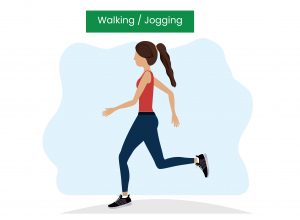
-
Squat Hold with Punches: 5 minutes with rest whenever required.
For Beginners: You can start off with a partial squat position or not necessarily the perfect squat position and start boxing at low to the medium pace at different levels (make a few punches at face level, make a few punches at chest level and a few punches at belly level). If your legs or arms feel tired; take a break for a couple of seconds until you recover partially and get back to performing the exercise again.
Pro Tip: Get into a comfortable deep squat position; hold the position and try boxing alternatively with your hands. Take breaks only when needed.
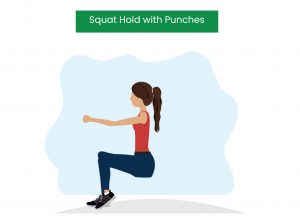
-
Butt Kicks: 5 minutes with rest when-ever required.
For Beginners: You can start off with bending your right knee towards butt and lowering the right knee completely on the floor and repeating the same with the left leg. Work towards increasing the pace gradually and try to reach the level of Jumping Butt kicks. (Refer to pro tip)
Pro Tip: Stand with feet right under your shoulders. Swiftly bend your right knee backwards; as if you are trying to touch your heel to your butt; while lowering the right knee towards the floor; hop and bend your left knee towards your butt. Repeat the same movement for 5 minutes while taking rests whenever required.
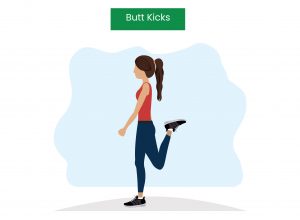
-
Apple Picker to basket Exercise: 5 minutes with rest when-ever required.
For beginners: You can start off in Standing with feet right under your shoulders. Imagine you are standing under an apple tree with a basket in between your legs; Raise your shoulder as an act to pluck an apple for the tree and do a mini squat to lower yourself to drop the apple in the basket. If you get tired; continue with the apple plucking action and drop it in the imaginary basket without having to squat.
Pro Tip: Stand with feet right under your shoulders. Imagine you are standing under an apple tree with a basket in between your legs; Raise your shoulder as an act to pluck an apple for the tree and do a deep squat to lower yourself to drop the apple in the basket. Take rest whenever required.
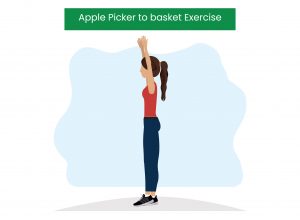
-
Invisible Skipping rope Jumping
15 counts of skipping with 30 steps of walking around and repeat the cycle for 5 mins with break when-ever required.
For Beginners: Stand with feet right under your shoulders. Imagine you are holding a skipping rope and perform 15 skipping jumps followed by 30 steps of walking around and repeat the 15 skipping jumps followed by 30 steps of walking around and repeat the same for the next 5 minutes.
Pro Tip: Perform 30 skipping jumps followed by 15 steps of walking and repeat.
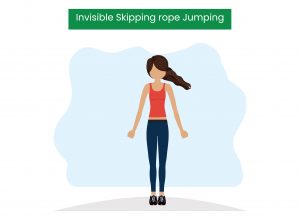
-
Walking on the spot: 5 mins
Mimic walking slowly on the same spot for 5 minutes to cool down your body.
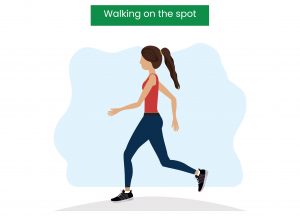
-
Stretching:
Perform stretches for Hamstring, Glutes, Lower back and shoulders; each stretch held for 30 seconds.
Do this workout every alternate day coupled with 45 minutes walking during the rest days.


